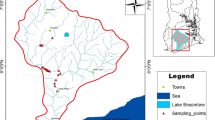Abstract
Salt-marsh estuarine sediments are not homogeneous. It is obvious that a steady state cannot be assumed if the depositional environments under which salt marshes accumulate change from subtidal through non-vegetated intertidal to vegetated intertidal state during their formation. In addition to these, the supply of sedimentary material depends on the tidal prism which changes as salt marshes are formed. Based on the study of cores collected in the estuarine region of Georgia, USA, it was found that the Mn/Al ratios in sediments of marsh cores change from subtidal through non-vegetated intertidal to vegetated intertidal. The relative variation of biogenic silica preserved in sediments of marsh core reflects the relative supply rate of organic carbon (phytoplankton) produced in the water column to the sediment surface at the time of deposition. In this paper it is proposed that sediment manganese and biogenic silica may be applied as geochemical indicators of changing depositional environments and organic carbon originating from phytoplankton in the estuarine salt marsh sediments.
Similar content being viewed by others
References
Aller, R.C. and Benninger, L.K. 1981. Spatial and temporal patterns of dissolved ammonium, manganese, and silica fluxes from bottom sediments of Long Island Sound, U.S.A. Journal of Marine Research, 39, 295-313.
Berner, R.A. 1980. Early Diagenesis. Princeton University Press, Princeton, NJ, 241 pp.
Broecker, W.S. and Peng, T.H. 1982. Tracers in the Sea. Eldigio Press, Lamont-Doherty Geological Observatory, Columbia University, NY, 690 pp.
Chen, Y.C. 1993. Trace element distributions in salt marsh sediments: the relative importance of non-steady state and diagenetic processes. PhD Thesis, Georgia Institute of Technology, 172 pp.
Delaune, R.D., Reddy, C.N. and Patrick, W.H. Jr 1981. Accumulation of plant nutrients and heavy metals through sedimentation processes and accretion in a Louisiana salt marsh. Estuaries, 4, 328-34.
Fogel, M.L., Sprague, E.K., Gize, A.P. and Frey, R.W. 1989. Diagenesis of organic matter in Georgia salt marshes. Estuarine, Coastal and Shelf Science, 28, 211-30.
deJonge, V.N. 1985. The occurrence of ‘Epipsammic’ diatom population: a result of interaction between physical sorting of sediment and certain properties of diatom species. Estuarine, Coastal and Shelf Science, 21, 607-22.
Lynn, D.C. and Bonatti, E. 1965. Mobility of manganese in diagenesis of deep-sea sediments. Marine Geology, 3, 457-74.
Mayer, L.M., Peter, T.R., Guerin, W., Macko, S.A., Watling, L. and Anderson, F.A. 1985. Biological and granulometric controls on sedimentary organic matter of an intertidal mudflat. Estuarine, Coastal and Shelf Science. 20, 491-503.
McCaffrey, R.J. and Thomson, J. 1980. A record of the accumulation of sediment and trace metals in a Connecticut salt marsh. Advances in Geophysics, 22, 165-236.
Mortlock, R.A. and Froelich, P.N. 1989. A simple method for the rapid determination of biogenic opal in pelagic marine sediments. Deep Sea Research, 36, 1415-26.
Oertel, G.F. and Dunstan, W.M. 1981. Suspended-sediment distribution and certain aspects of phytoplankton production off Georgia, U.S.A. Marine Geology, 40, 171-97.
Rantala, R.T.T. and Loring, D.H. 1975. Multi-element analysis of silicate rocks and marine sediments by atomic absorption spectrophotometry. Atomic Absorption Newsletter, 14, 117-20.
Storti, F.W. 1980. The geochemistry of Pb-210 in the southeastern U.S. estuarine system. MS Thesis, Georgia Institute of Technology, 42 pp.
Strickland, J.D.H. and Parsons, T.R. 1972. A Practical Handbook of Seawater Analysis, 2nd edn, Bulletin of the Fisheries Research Board of Canada, 167, 310 pp.
Sundby, B. and Silverberg, N. 1985. Manganese fluxes in the benthic boundary layer. Limnology and Oceanography, 30, 372-81.
Tiffany, L.H. and Britton H.E. 1952. The Algae of Illinois. University of Chicago Press, Chicago. 407 pp.
Trefry, J.H. and Presley, B.J. 1982. Manganese fluxes from Mississippi Delta sediments. Geochimica et Cosmochimica Acta, 46, 1715-26.
Windom, H.L., Schropp, S.J., Calder, F.D., Ryan, D.J., Smith, R.G., Jr, Burney, L.C., Lewis, F.G. and Rawlinson, C.H. 1989. Natural trace metal concentrations in estuaries and coastal marine sediments of the southeastern United States. Environmental Science and Technology, 23, 314-20.
Author information
Authors and Affiliations
Rights and permissions
About this article
Cite this article
Chen, YC., Windom, H.L. Sediment manganese and biogenic silica as geochemical indicators in estuarine salt marshes of coastal Georgia, USA. Environmental Geochemistry and Health 19, 0 (1997). https://doi.org/10.1023/A:1018434018126
Issue Date:
DOI: https://doi.org/10.1023/A:1018434018126




